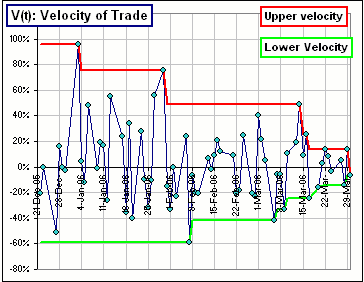| Velocity of Trade |
Suppose we have some stock or option or mutual fund and we want to see how quickly it achieves some target price.
>Huh?
Assume the current price of the asset is Po. Example: Po = $57.60
We'd like to (eventually) reach a target price of TP. Example: TP = $60.00
The price would then have to travel a distance of TP - Po. Example: TP - Po = $2.40
Suppose that, after t days, the price is P(t). Example: P(3) = 58.45
Then the price has travelled a distance of P(t) - Po. Example: P(3) - Po = $0.85
As a fraction of the distance required to achieve our target price, that's X(t) = (P(t) -Po) / (TP-Po)
Example: X(3) = (0.85) / (2.40) = 0.35 or 35%
Now, we'd like to see how rapidly our asset price is moving, in the direction of the target price, so ...
>So that's the velocity: V = dX/dt, right?
Well, our t-values don't change continously. They're t = 0, 1, 2, etc., so we consider:
V(t) = (X(t) - X(t-1) ) / (t - (t-1)) = X(t) - X(t-1).
Now the graph of X(t) = (P(t) -Po) / (TP-Po) looks just like the price graph P(t)
(except for some rescaling) as shown in Figure 1.
So V(t) = X(t) - X(t-1) is just (P(t) -P(t-1)) / (TP-Po) is just the velocity associated with the price-graph
(except for some rescaling).
That's shown in Figure 2.
 Figure 1 |
 Figure 2 |
Them's just some level lines to see how you're doin'.
>So how come that velocity is sometimes negative, sometimes positive?
When the price increases the velocity is positive and when it decreases the velocity is negative.
There's a spreadsheet to play with ... just click on the picture;
Here's some more pretty pictures:



>So we're talkin' stock prices, eh?
Well, if we were talking options, then this "velocity" would be related to
theta.
>And it's useful?
Useful to whom?

